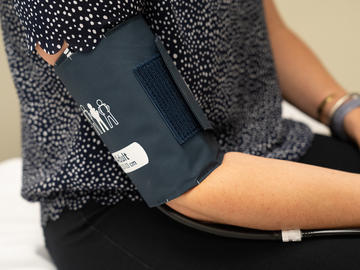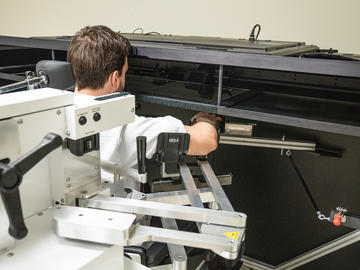Current Research

The RESTORE Network Stroke Team is committed to developing novel methods for assessing and treating individuals with neurological disorders, particularly individuals who have suffered a stroke. Using new robotic technology we are developing more accurate assessment tools to examine sensorimotor function following neurological damage. Using our robotic exoskeleton, we are helping improve stroke rehabilitation, and getting a deeper understanding of the mechanisms for stroke recovery. Our team is also involved in anatomically mapping and correlating brain lesion locations post-stroke to sensorimotor deficits.
REhabilitation, STroke deficits And Robotic Technology
RESTART uses the Kinarm robotic exoskeleton to assess neurological function of a patient after a stroke. Determining the nature and size of a problem in neurological function (i.e. someone's movement, sensation, and vision) after someone has had a stroke is important because this can help guide a patient's rehabilitation program. Further accurate measures of neurologic function can help to track progress with treatment and potentially predict recovery.
Traditionally assessment of neurological function has been determined through various observer based clinical tests done by doctors and therapists. However, many of these clinical tests may not be able to detect small changes in function, or be sensitive enough to pick up on subtle deficits that have developed from the patient's stroke. Many of these clinical tests are quite long to complete, and rely heavily on the clinical experience and impression by the examiner.
Members of the Dukelow Lab take a novel approach to assessment of neurological function after a stroke using new robotic technology. The Kinarm robotic exoskeleton is used to assesses performance in a subject's sensorimotor system, through a suite of simple interactive tasks. Use of robotic assessment has significant advantages for determining neurologic function following stroke as robotic assessments are much more sensitive to subtle changes in a patient's function. Robots have the ability to measure subjects movement and reaction time down to the millimetre and millisecond. Robotic assessments can be preformed fairly quickly when compared to many of the clinical tests, and do not rely on the examiners own experience or impression, as the robotic analysis are performed the exact same way each time they are done. Use of robotics to assess neurological function will ultimately allow the potential for health care professionals to better determine a patient's function before they start their therapy, and then better track and assess how a patients is improving in their rehabilitation program.
Along with the Kinarm robotic assessment, this study involves neuroimaging in stroke. Using CT and MRI scans of stroke patients, we are trying to anatomically map and correlate brain lesion locations to cognitive and sensorimotor deficits in stroke survivors.
Robot Enhanced Stroke Therapy Optimizes REhabilitation
RESTORE is a prospective randomized controlled trial looking at the impact of early intensive robotic rehabilitation on stroke recovery. Participants are randomized into different groups that will receive extra therapy time using the Kinarm robotic exoskeleton. Using the Kinarm, participants will go through a series of tasks to exercise the upper extremity as part of their rehabilitation program.
Using the Kinarm allows us to do many more repetitions to exercise the arms in a shorter amount of time then would be typically possible in a standard therapy session with a therapist. The Kinarm will be able to make several hundred of repetitions with the participant, and allow them to potentially push themselves harder, working as close to their own maximum ability as they can, in a safe and controlled setting. The Kinarm can also measure and track any improvements that the stroke survivors make, down to the millisecond and millimetre, so that our participants can see small changes from day to day that may not be noticeable to them in daily activity.
FLuoxetine to Open the critical period time Window to improve motor recovery after stroke
Improving lower extremity mobility following a stroke event is one of the top priorities agreed upon by stroke survivors, caregivers and health professionals. Improvements in lower extremity mobility reduce the likelihood of being discharged to long term care nursing homes and increase the probability of improved quality of life post-stroke. Findings over the past 15 years suggest that in the first weeks following a stroke or similar injury the brain enters a recovery period characterized by rapid neuronal growth which leads to increased neuroplasticity. Previous animal and human studies have demonstrated that rehabilitation of stroke survivors is most effective during this relatively short time period.
Recent studies suggest that it may be possible to re-open and extend this critical time period for the rehabilitation and increase the overall recovery outcomes of stroke survivors. The primary objective of the FLOW Trial is to keep re-open and extend this optimal recovery window for those affected by stroke through a combination of fluoxetine (Prozac) and intensive exercise. Other recent studies in stroke, have shown that a increase in exercise intensity, can lead to greater improvements in motor and neurologic function; so by combining increased activity with fluoxetine, there may be potential in increase the rate at which people improve and level to which they improve to even further. Using preliminary evidence that Selective Serotonin Re-uptake Inhibitors (SSRI’s) such as fluoxetine have potential to optimally enhance motor function when combined with exercise, the FLOW trail aims to improve the recovery prognosis and fundamental outcomes of Canadians living with stroke.
REpetitive TMS and Multi-modality Aphasia therapy for Post-stroke aphasia
Many stroke survivors have aphasia, an impairment of language affecting the production or understanding of speech and the ability to read and write.
Non-fluent aphasia often results from stroke-related damage to Broca’s area. Recent research has focused on using brain stimulation to augment recovery of non-fluent aphasia. Several small studies have suggested 1 Hz repetitive Transcranial Magnetic Stimulation (rTMS) over the contralesional right pars triangularis (the right sided homologue of Broca’s area), when coupled with speech language therapy, can improve speech production in individuals with non-fluent aphasia poststroke. rTMS appears to inhibit inappropriate recruitment of the right pars triangularis in language production and promote reorganization of the left hemisphere when coupled with speech language therapy (SLT) leading to improvements in language function.
More intense SLT may encourage greater neuroplasticity and promote better recovery of language. Pairing rTMS with more intensive SLT treatments could potentially lead to better outcomes in stroke survivors with longstanding aphasia. One such intensive, novel SLT treatment is a technique known as Multi-Modality Aphasia Therapy (M-MAT). M-MAT improves spoken language production through shaping of responses and social-mediated repetitive practice. Participants work with a speech-language pathologist (SLP) in small groups for 2-4 hours/day for 2 weeks or more. We suspect pairing rTMS with M-MAT will result in significantly enhanced recovery of aphasia.
Further, language recovery post-stroke is traditionally thought to occur mainly in the first 2-3 months. Recent studies, however, on early SLT versus later therapy have shown mixed results. We are not aware of any rTMS trials that directly examine the impact of varying timing post stroke. Thus, we plan to compare sub-acute stroke (<3 months post-stroke) and chronic stroke (>6 months post-stroke) to better understand how timing affects response to our intervention.
Effect of Robotic Therapy and tCDS on Motor Function in Children with Cerebral Palsy
Throughout the lifespan, the most focused period of risk for ischemic stroke is the week you are born. Perinatal ischemic stroke occurs in >1:2,000 live births and is a leading cause of lifelong disability in children, with the impact extending to the family and lasting decades. Perinatal stroke is responsible for the vast majority of the >10,000 Canadian children affected by hemiplegic cerebral palsy (HCP). Children may also have bilateral CP where they have deficits on both sides of their body.
At present, rehabilitation is one of the few treatments for CP. Traditionally this has involved hand over hand training with a therapist to regain function, but more recently technologies such as robotics and non-invasive brain stimulation with transcranial direct current stimulation (tDCS) have surfaced as promising experimental treatments. Robotics allow children to interact with virtual reality environments and play games to force increased use of the arm while tDCS safely modulates neuronal activity in specific areas of the brain. Our team has more experience using robotics and non-invasive stimulation in pediatric HCP than any other center in the world. Our previous work has successfully used robots to define new understandings of sensory and motor dysfunction in HCP. We have also conducted positive clinical trials showing that brain stimulation can enhance motor learning in typically developing children and enhance therapy in those with HCP.
Neurological Recovery Supported by Remote Virtual Reality
Along with Red Iron Labs, a local Calgary company, we are developing the Neuro RecoVR - Remote platfrom, a new and innovative virtual reality treatment platform designed specifically for remote stroke rehabilitation. The platform will be built to help physicians, therapists and other caregivers treat patients with motor and cognitive impairments. The aim of the Neuro RecoVR platform is to empower patients to enhance their recovery by participating in personalized rehabilitation from the comfort of their own home. Through engaging gamified VR activity modules, stroke survivors will complete challenges specifically designed to help restore lost neurological functions. Activity modules are being created to target specific aspects of recovery to support improvements in motor function & cognition (visuospatial attention, memory, executive function, speech). With continued use and engagement, the platform will adapt and change the difficulty of the gamified exercises to harness neuroplasticity and improve stroke recovery. In addition, the platform will collect data from each session to track the performance of stroke survivors and information will be accessible to members of the healthcare team. Medical professionals will be able to review and compare the data collected from each session, as well as adjust the difficulty and treatment focus for subsequent sessions with the platform.




